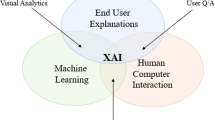Abstract
In this paper we show how machine learned KPI goal preference relations based on interactions between KPI goals are used to explain results of an AI algorithm for optimization of real-world production sequences. It is also shown how such algorithms can be both parameterized and reparametrized in an explainable ad-hoc and post-hoc manner. The explanations are also used to manage contradictory and counterfactual optimization effects so that uncertainty in the decision situations before releasing the sequences to production is handled better than if only the pure sequences were presented.
Access this chapter
Tax calculation will be finalised at checkout
Purchases are for personal use only
Similar content being viewed by others
References
Carvalho, D., Pereira, E., Cardoso, J.: Machine learning interpretability: a survey on methods and metrics. Electronics 8, 832, MDPI (2019)
Felix, R.: Optimization of partly conflicting goals in complex resource planning. In: Proceedings of the 8th EUSFLAT Conference, Milano, Italy, pp. 669–674 (2013)
Felix, R.: On separability of preferences and partly consistent induced interacting goals. In: Proceedings of the IFSA-EUSFLAT International Joint Conference, Gijón, Spain (2015)
Felix, R.: Learning of consistent preference relations for decision making and optimization in context of interacting goals. In: Proceedings of the IFSA-EUSFLAT-AGOP International Joint Conference, Bratislava, Slovakia, pp. 266-273.Cooper, M.C. (2021)
Felix. R. The optimization of capacity utilization with a fuzzy decision support model. In: Proceedings EUSFLAT-ESTYLF, Palma de Mallorca, pp. 461–463 (1999)
Fuchigami, H.Y., Rangel, S.: A survey of case studies in production scheduling: analysis and perspectives. J. Computat. Sci. 425–436, Elsevier (2018)
Ghai, B., Liao, V., Zhang, Y., Bellamy, R., Mueller, K: Explainable active learning (XAL): toward AI explanations as interfaces for machine teachers. Proc. ACM Hum. Comput. Interact. 1(1), 28 (2020)
Gordo, A., Almazán, J., Murray, N., Perronnin, F.: LEWIS – Latent Embeddings for Word Images and their Semantics. arXiv:1509.06243
Guidotti, R., Monreale, S., Ruggieri, A., Turini, F., Pedreschi, D, Gianotti, F.: A survey of methods for explaining black box models. ACM Comput. Surv. 51(5), 1–42 (2018)
Jeyasothy, A., Laugel, T., Lesot, M., Marsala, C., Detyniecki, M.: Integrating Prior Knowledge in Post-hoc Explanations. arXiv:2204.11634
Kowsari, K., Bari, N., Vichr, R., Goodarzi, F.A.: FSL-BM: fuzzy supervised learning with binary meta-feature for classification. In: Arai, K., Kapoor, S., Bhatia, R. (eds.) FICC 2018. AISC, vol. 887, pp. 655–670. Springer, Cham (2019). https://doi.org/10.1007/978-3-030-03405-4_46
Laugel, T., Lesot, M.-J., Marsala, C., Renard, X., Detyniecki, M.: Comparison-based inverse classification for interpretability in machine learning. In: Medina, J., Ojeda-Aciego, M., Verdegay, J.L., Pelta, D.A., Cabrera, I.P., Bouchon-Meunier, B., Yager, R.R. (eds.) IPMU 2018. CCIS, vol. 853, pp. 100–111. Springer, Cham (2018). https://doi.org/10.1007/978-3-319-91473-2_9
Mehdiyev, N., Fettke, P.: Explainable artificial intelligence for process mining: a general overview and application of a novel local explanation approach for predictive process monitoring. In: Pedrycz, W., Chen, S.-M. (eds.) Interpretable Artificial Intelligence: A Perspective of Granular Computing. SCI, vol. 937, pp. 1–28. Springer, Cham (2021). https://doi.org/10.1007/978-3-030-64949-4_1
Rudolf, G., Felix, R.: KPI-orientierte Optimierung von Produktionssequenzen in der Auto-mobilindustrie und KI-Methoden, Slide 27, VDA Forum Automobillogistik (2019)
Stauder, M., Kühl, N.: AI for in-line vehicle sequence controlling: development and evaluation of an adaptive machine learning artifact to predict sequence deviations in a mixed model production line. Flexible Serv. Manufact. J. 34, 709–747 (2022)
Tahriri, F., Dawal, S.Z., Taha, Z.: Fuzzy mixed assembly line sequencing and scheduling: optimization model using multiobjective dynamic fuzzy GA. Sci. World J. 505207, 20 (2014)
Wachter, S., Mittelstadt, B., Russell, C.: Counterfactual explanations without opening the black box: automated decisions and the GDPR. Harvard J. Law Technol. 31, 841–887 (2018)
Wang, K., et al.: Cost-effective active learning for deep image classification. IEEE Trans. Circ. Syst. Video Technol. 27(12), 2591–2600 (2016)
Wang, L., et al.: Active learning via query synthesis and nearest neighbour search. Neuro-computing 147, 426–434 (2014)
Wang, P.: On defining artificial intelligence. J. Artif. Gen. Intell. 10(2) 1–37, Sciendo (2019)
Zhang, R., Chang, P.C., Wu, C.: A hybrid genetic algorithm for the job shop scheduling. Int. J. Product. Econ. 145(1), 38–52 (2013). ISSN 0925–5273
Author information
Authors and Affiliations
Corresponding author
Editor information
Editors and Affiliations
Rights and permissions
Copyright information
© 2023 The Author(s), under exclusive license to Springer Nature Switzerland AG
About this paper
Cite this paper
Felix, R. (2023). Machine Learned KPI Goal Preferences for Explainable AI based Production Sequencing. In: Honda, K., Le, B., Huynh, VN., Inuiguchi, M., Kohda, Y. (eds) Integrated Uncertainty in Knowledge Modelling and Decision Making. IUKM 2023. Lecture Notes in Computer Science(), vol 14376. Springer, Cham. https://doi.org/10.1007/978-3-031-46781-3_8
Download citation
DOI: https://doi.org/10.1007/978-3-031-46781-3_8
Published:
Publisher Name: Springer, Cham
Print ISBN: 978-3-031-46780-6
Online ISBN: 978-3-031-46781-3
eBook Packages: Computer ScienceComputer Science (R0)




